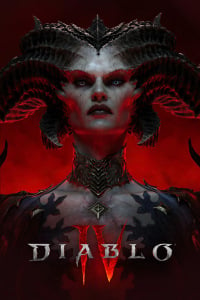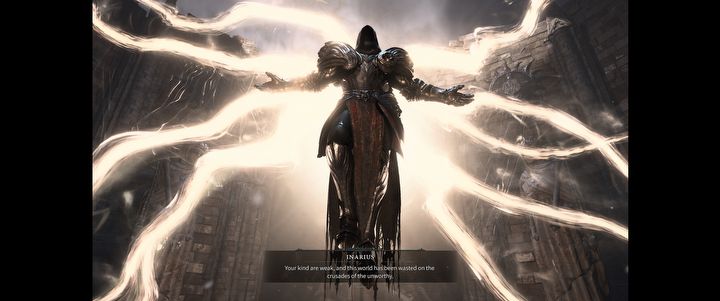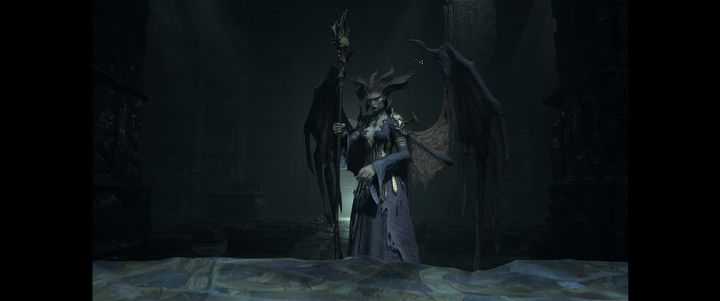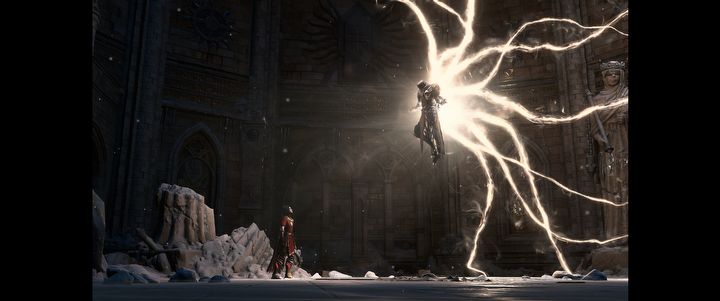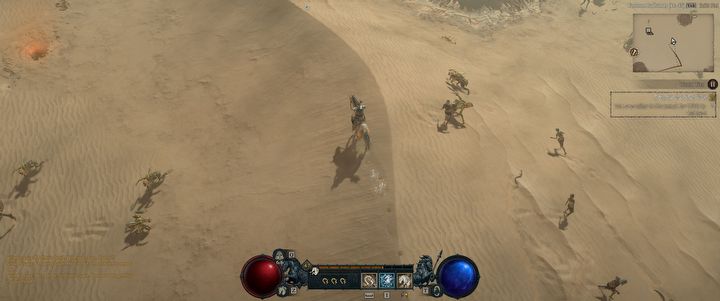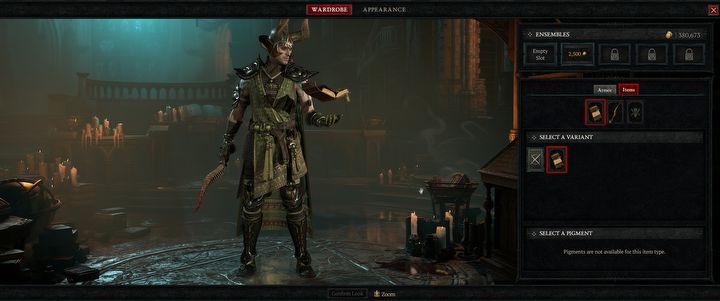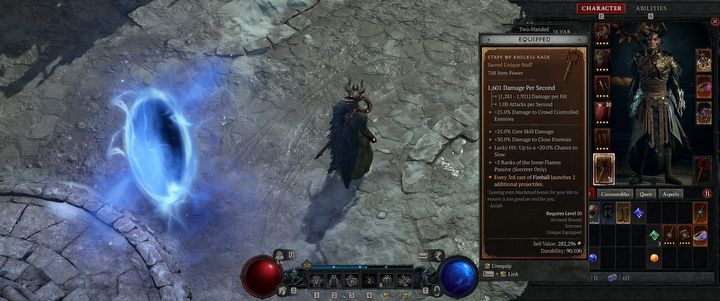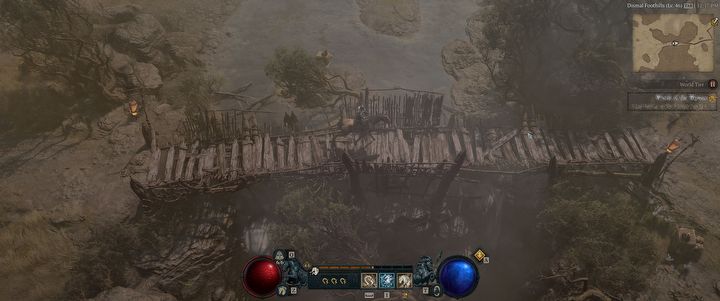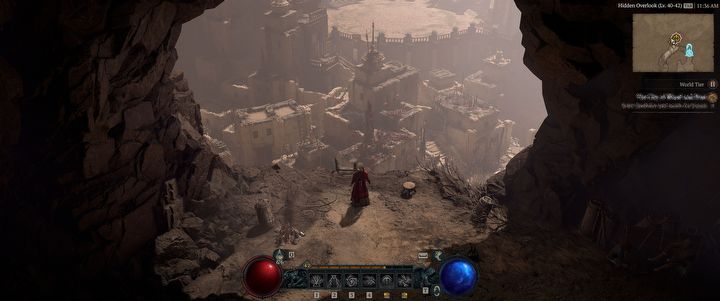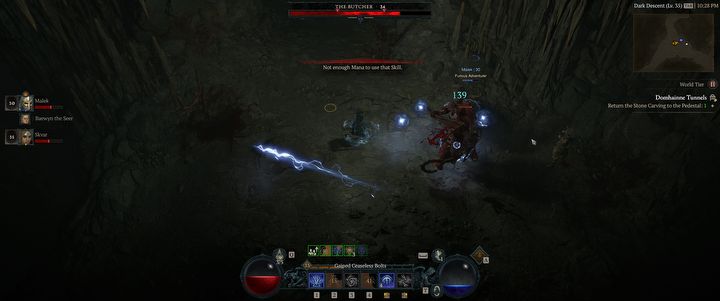Diablo 4 Review: Blizzard Remembered How to Make a Great Game!
We've been waiting for years, but it's finally here - the new Diablo 4 with a great campaign and addictive combat. Read our review, because it was really worth the wait!
The review is based on the PC version. It's also relevant to PS4, XONE, PS5, XSX version(s).
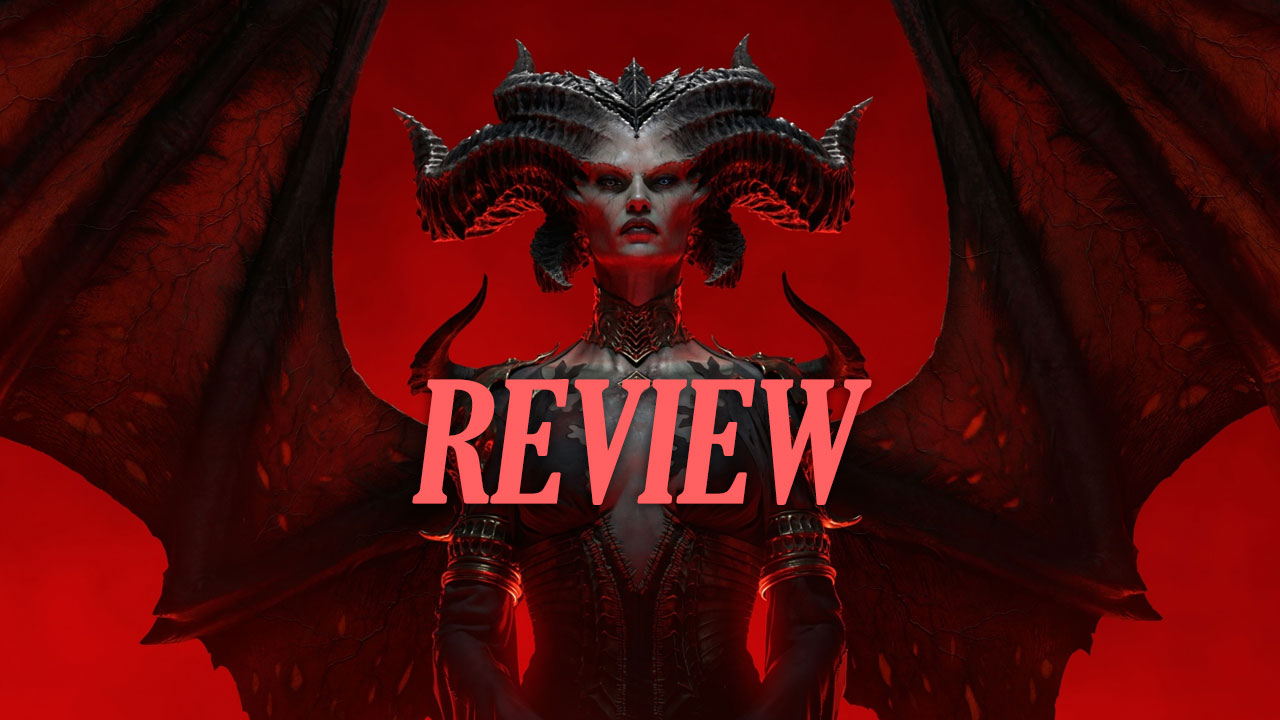
You won't believe it, but Blizzard still seems to remember how to make great games. After 11 years, the great hack'n'slash returns and I'll say it right away – Diablo 4 is the best Diablo I've ever played and it is one of the most wonderful games of recent years. This is also a great experience for... for single players!
Diablo IV Review without spoilers!
In this review, you will not come across any plot spoilers. Fear not!
It is impossible to make a Diablo series game that would satisfy everyone. It's a brand that brings together casuals, hardcore gamers, people looking for a single-player experience, as well as those who love multiplayer. PVE, sure, but there are also those who love PVP above all else. There are those who perfect their builds in the smallest details, and those who just want to cast spells and swing a sword. In the end, there are those who pay attention to the world, story, and lore, and those for whom the gameplay loop is the most vital element. After the release of Diablo 4, each of these groups will have dissatisfied people, and perhaps Blizzard tried to please everyone. But I think it worked – Diablo 4 starts off as a very good, complete game for single-players and provides a solid foundation for further expansions, patches, content, and what not.
- Insanely dark, gritty, and sometimes straight-up depressing vibe.
- Hands down the best storyline in Diablo ever.
- Non-stop, adrenaline-pumping combat that'll keep you hacking, slashing, chopping, and annihilating!
- Tons, and we mean tons, of solo play goodness, brimming with side quests.
- 5 character classes with room for epic all sorts of build variations.
- Looks like some killer end game content is coming.
- Bleak color tone makes individual bioms seem alike.
It's also impossible to write a review for all Diablo 4 fans. Each of us focuses on something different and expects a something else from the game. And then writing a review for Diablo IV is extremely difficult because the game will be constantly changing. One skill is OP on the release day, only to be nerfed two weeks later. That's why I will focus primarily on the game's merits and potential weaknesses – an in-depth analysis of builds and the relationships existing between the mechanics will be described in other articles, and our Diablo 4 guides.
Diablo 4 end content – review
It is impossible to review end content in such a short time, so in this review, I shall only indicate what end game content looks like in Diablo 4 – a full analysis and review of the end content will be published in a separate text, after spending at least 2-3 weeks with the game post-launch.
The best story in the series
If you were worried about the story in Diablo IV, you were wrong. This is the best single-player campaign in the series, taking us on a wild ride that lasts several hours. That's right: if you don't rush, completing the main story of the game will take you around 15 hours, maybe a few more. Blizzard has definitely extended the previously developed formula, adding a few twists to it. We will meet characters with their own personalities, background, depth – you can either like them... or hate them! These are not some inanimate dolls; they're heroes who know they have reached the edge of a very deep abyss. You will witness major events, those that decide the fate of the world, but interestingly, Blizzard has managed to skillfully portray the fate of the world from the perspective of a group of pretty ordinary people. People who seemingly stand no chance against powerful evil forces.
The world you end up in is so gloomy and sad that, all in all, you quickly stop being surprised that everyone you meet is complaining. Of course, gloomy atmosphere is nothing new in the Diablo series – it's a world that seems to have ended long ago, and the battle for it seems lost. But in Diablo 4, the feeling is much more tangible. Hunger is prevalent everywhere, there's stagnation and depression, and ordinary people are being slaughtered in meat grinders.
Lilith – a demoness – is summoned to the Sanctuary, which she actually created herself together with Inarius (an angel). We, as a matter of coincidence, cross paths with her way and start chasing after her. Diablo begins, just like previous parts, by setting up two sides of the conflict... but not quite, because for some reason, a demonic dog hiding its identity is helping us, and the behavior of people with whom we have to ally is not all that noble. In addition, the Horadrim and a bunch of smaller factions are also involved in all this. So, it quickly turns out that not everything here is simple and easy to distinguish. Who is behind whose back? Who's right? Who's good?
The story from the beta, i.e. the first act of the game, quickly turns into a suspenseful thriller. You could have already noticed this in Kyovashad (the city from Act I), but it's worth emphasizing. Nothing is black and white here – the characters and groups we encounter have their virtues, but they also have flaws. It was nice to enter the Sanctuary, in which there are definitely more shades of gray than of easily distinguishable good and evil. The conflict between angels and demons, known from the Sanctuary, was often presented in a binary way. This time it's different – morality in Diablo 4 has become much more dependent on the point of view. Instead of a clear distinction between good and evil, you will enter a world that operates on a much larger scale of grayness. The good can have its bad sides. The evil can also have a brighter face.
You will often feel at home – the first task (known from the beta) that you will receive sends you to a nearby dungeon where "evil has nested" and it immediately reminds you of the 1st quest from Akara in Diablo 2, clearing the Den of Evil. There are more references to previous parts, and those who have played and remember them will find many pleasing references.
Essentially – the plot, world, lore, and even characters are a definite upside of this edition, and I'm writing this, quite frankly, with surprise. But Diablo has accustomed us to the simple patterns; spectacular but uncomplicated events, in which it was easy to understand who was right. This time the issue seems to be much more difficult to pin down.
Grey, cold, sad
Gloom, depression, and omnipresent apathy in the Sanctuary can be felt in the game world design itself. If the colorful Diablo 3 irritated you, you will certainly be pleased that this time, the color palette definitely has less saturation. Grayness, cold, frost are everywhere – the grass that covers the land, although greenish, doesn't resemble the grass from Disney fairy tales. Everything looks as if it has been washed too many times and has lost its colors. At first, it even bothered me (I never shared the resentments about Diablo 3), but then I simply got used to it. I definitely miss some warmth here, but I understand the concept of a world, in which there's no longer any room for warmth.
The consequence of such a color palette, however, are less exciting regions. Biomes, of course, change – snow gives way to grass or desert sands, but despite this, everything seems to be "washed out" and if we do not pay attention to details, we may get the impression that we're still moving around the same region. And that's actually not true, because they differ from each other – without unnecessary spoilers: we will visit villages of barbarians and towns controlled by the Cathedral, groves of druids, and even witch villages. Swamps and dark forests, steppes and hills (the Diablo 4 map is not "flat" this time), you will run through desert dunes, fallen cities, and completely insane, blood-soaked locations. Designers have developed a large, extensive game map, so you will be looking for secrets, treasure chests, or Altars of Lilith scattered all over the map (on a side note, we have prepared an interactive map for Diablo 4 with all the Altars of Lilith, so be sure to check it out after reading this review!).
By the way, this leads us to one of the biggest changes in D4 – the world is no longer procedurally generated; the map is mostly hand-made. Does it affect the fun? To be honest, I didn't get that impression – the map is so vast that there's always something left to discover. The main tasks do not lead us through all of its corners, so when you finish the game, a significant part of it will still be waiting to be explored. The desert made the biggest impression on me, which is quite strange, because I usually find deserts boring. Meanwhile, in Diablo 4, the desert land of Kehjistan and the monstrous Caldeum were the most interesting for me (perhaps because they stand out so strongly from the grayish greenery and snowy white of other regions).
Interestingly, as you might know, you can acquire a horse in Diablo IV. You unlock the mount quite late in the campaign, but after you do, instead of running around the area and fighting through monsters, I started to ignore them and headed towards the objective. The mount will be perfect for the end game and quick execution of tasks, yet it can change the rules of the game. Is it for the better? Time will tell.
Combat and character classes
As you surely know, this time we have a choice between a wizard, druid, rogue, barbarian, and necromancer. Blizzard decided to play it safe here, using well-known and beloved character classes from previous installments. Some people might complain about the lack of a paladin, but there are still years of game development ahead, so maybe the class will join the roster later on.
I finished Diablo 4 with a wizard at around level 54, more precisely at the level cap of 50 + 4 paragon mastery levels (this system returns from Diablo 3), but I also tried a druid, necromancer, and rogue. I devoted the smallest amount of time to the barbarian.
The 50-level cap will certainly be increased in subsequent expansions, and for now, it was enough to get the feel of the character progression. Classes differ significantly from each other, and their efficiency, flaws, and advantages will change depending on nerfs, buffs, or, in other words, on patches. It's difficult to determine which class is best. So I'll write it differently: there is plenty of fun in killing demonic enemies, and the game doesn't lose its appeal even when we decide to choose a single element/skill group. For example, I've spent a lot of time with the lightning sorceress – striking with lightning was just as satisfying at the 5th level of development as it was at the 50th. Blizzard has once again created an incredibly engaging combat system – everything is satisfying and encourages plowing through legions of enemies. With great pleasure, I mowed down wave after wave of the undead, which would attack me in groups of 10, 20 at a time, and moments later their corpses, previously flung into the air, would pile up on the blood-stained ground. I think it is also worth appreciating the physics of the environment and the characters. We can smash many decorative elements into dust, and it brings simply inhuman, demonic joy.
By the way, I played on Veteran (the second highest level of difficulty available at the beginning of the game – the rest you unlock after completing the game) and the lightning sorcerer turned out to be an absolute killing machine, mainly due to the powerful Chain Lightning. In the whole game, I died only a few times, mostly due to my own carelessness. However, I had the impression that this was happening mainly due to my build – not low level of difficulty. Interestingly, when I finished the game and unlocked the Nightmare difficulty level... well, that was a completely different story; you will likely die frequently and suddenly.
The skill tree of each class offers a variety of active and passive bonuses for your builds. You can choose a single type, or mix them up if you want. Nothing prevents your sorceress from shooting a lightning bolt and freezing someone shortly after. If you are not experts in creating builds, just remember that as long as you match legendary items to your skills, your characters should do well. At least during the first playthrough, when opponents are more forgiving. Some skills present themselves spectacularly, and using them brings a lot of joy. The weight of weapons is also nicely conveyed – indeed, we get the impression that we're wielding a heavy axe or controlling powerful magic. Especially the ultimates make a big impression and can quickly tip the scales of victory in our favor, although they obviously have the longest cooldown (about 1 minute).
The barrier rewrites the rules
I also have to mention the barrier (shields) system, which is currently the cornerstone of Diablo 4's mechanics. It's not about armor, but a temporary health buff that activates under certain conditions. It's activated either by a special ability, passively, by performing some action, such as activating any ability that burns the main resource (ie. mana) or just by receiving damage from an elite monster. Then our life becomes frozen and we can withstand much more damage. There are barriers that last longer (for example 10 seconds), as well as very short ones, e.g. 2 seconds. The shorter ones are extremely important – for example, when playing as a sorceress we can teleport. This ability is rather straightforward, it definitely isn't the most powerful offensive spell, but the right item allows us to activate a 2-second barrier. Imagine now that you're fighting against a boss or an elite enemy. You see that the opponent is about to launch a powerful attack, which can swiftly dispose of most of your health points. With the 2-second barrier, you can take the attack instead of trying to dodge it, so you can keep the pressure up. All this forces us to play a bit more carefully. It's easy to understand that barriers are essential, so looking for items that enhance or activate them will be important. In this way, the fights not only are a big hack-and-slash party, but they also got more complex with the need to control, apart from cooldowns and resources, also barriers.
Items straight from hell
The fun part of this series for me were always the items. In Diablo 4, we again have the division into basic white, magical blue, rare yellow, and legendary orange items, which, in addition to great stats and sleek appearance, also have special, legendary affixes that usually somehow strengthen or change our skills. But that's not all, because Blizzard has also introduced another tier of items: after unlocking higher difficulty levels, we can find unique items – these are powerful items in gold color and I have a feeling that they will determine the power of your character on the highest difficulty level, Torment. In the endgame, we will also unlock sacred items, i.e. enhanced versions of legendary items (with even better affixes). However, I must admit that unique items drop from monsters very rarely – unlike legendary ones, which appear occasionally until about halfway through the first playthrough. After finishing the game, though, we're literally showered with them. But unique items are the new trend and a way to survive – I only had two of them, and one was a reward for completing the campaign.
Of course, the Smart loot system returns – it stipulates that drop from monsters will more often be appropriate for your character class (though, of course, not always). Another returning element is transmog – the ability to assign the stats of one item while preserving the appearance of another if you so please.
And speaking of appearance, it seems that Lucifer himself must have had a hand in their design! They're absolutely beautiful and impressive, and you will enjoy every new piece of gear you wear. To get a permanent transmog, you must first dismantle the item at the blacksmith. Then you lose the item, but gain its appearance forever. Acquiring the most interesting and beautiful apparel, however, involves sacrificing legendary or unique items, and that's a more difficult decision to make. Nevertheless, I even managed to dress up my sorceress as Marvel's Loki. Oh, and let's also add that, just like in Diablo 3, you can also change the color of your clothes in Diablo 4.
It's also worth noting that I am very satisfied with crafting. We can dismantle the acquired legendary item to obtain its affix, and then imprint this affix onto any non-legendary item. Thus we can create legendary equipment ourselves based on the objects that match our statistics. The system is simple and mostly affordable (it requires special materials), so we can use it even at lower experience levels. You will often create your own legends and transfer affixes between items.
A game for many nights
While previous installments of Diablo were rather short in terms of typical single-player content, Diablo 4 has 50 hours or more in stock for you. The campaign itself, as I mentioned earlier, is much longer, but Blizzard has placed dozens, even hundreds of side quests and activities on the world map and completing all of them will take away dozens of hours of your life.
Blizzard really catered both to those who enjoy single-player experiences, and those eager for some good old multiplayer fun. Seriously, break the piggy bank and go buy this game. Because Blizzard, apparently, did it again – they remembered how to make great games that we will be playing for months on end. Maybe even years.
Interestingly, the side quests themselves are really ok. Sure, some of them are typical fetch quests like "kill 10 boars," but there were gems that genuinely intrigued me. Now, it's not the level of Bloody Baron from Witcher 3, but these are some good stories making interesting arguments. By the way, some side quests are continued in later acts.
Next to side quests, we also have various dungeons, including the most important, aspect dungeons, which are rewarded with affixes for a legendary items. There are also fortresses, i.e. are cities filled with enemies, including elite ones. After cleaning those locations, residents can return to their settlement, providing you access to new vendors and side quests. Interestingly, the fortresses are freed permanently, which provides a nice feeling of agency in the game world. There are also events, random occurrences in the game world, where we will be defending caravans or fighting against waves of enemies. Here, other players can join regardless of our preference.
So even if you finish the game and aren't interested in end game, there's still a lot of content to complete – Blizzard made sure that people uninterested in online gaming have plenty to do. Exploration is nicely rewarded and it's sometimes better to give up the speed and convenience of your faithful mount in exchange for some thorough wall-licking.
This is the end
In contrast to previous installments, Blizzard made sure that Diablo 4 would launch with an interesting end game system already there. And although I don't think it's perfect yet, it seems a good foundation for further development of the game.
Tree of Whispers is an incredibly creepy (and also slightly amusing) place, where defeating significant opponents is rewarded with prizes (after completing the game, new activities from Tree of Whispers will appear on the world map). That's not all – we still can unlock higher difficulty levels (related to completing a certain, quite challenging dungeon) and, oh my Inarius, it suddenly becomes MUCH more difficult. Monsters suddenly have the punch of Mike Tyson – at least until you acquire some unique item that will boost your dmg by 100%.
After unlocking the Nightmare difficulty, even newer side activities appear on the map, in which you can collect another currency, useful for the special chests. All that, of course, in the name of obtaining better and better loot. In addition to this, there are nightmare dungeons – particularly difficult dungeons with varying conditions, as well as PVP, which, despite my sincere intentions, I did not have a chance to test because I simply did not meet anyone in them.
Of course, as part of the end game, you can simply try to clear the world map out, gain reputation for specific regions and unlock subsequent rewards. Who knows, maybe you'll even manage to meet the Butcher, who randomly haunts dungeons. I met him as we were doing a run of an aspect dungeon with the Wccftech editor (cheers!).
However, I didn't have a chance to test the battle pass nor season mechanics – there was also no vendors nor real currency in the game. I am also not able to determine how aggressive monetization will be. But we'll make sure to write more about it after the release. And we will return many times.
Afterparty in hell
When it comes to other players – I am among the great minority of players who will have experienced Diablo 4 as almost purely single-player experience (since access for journalists was very limited). And I realized that this time, Blizzard really catered both to those who enjoy single-player experiences, and those eager for some good old multiplayer fun.

Our reviews are featured on Metacritic.
Seriously, break the piggy bank and go buy this game. So, Blizzard, apparently, did it again – they remembered how to make great games that we will be playing for months on end. Maybe even years.
Diablo IV
Diablo 4 Review: Blizzard Remembered How to Make a Great Game!
We've been waiting for years, but it's finally here - the new Diablo 4 with a great campaign and addictive combat. Read our review, because it was really worth the wait!
